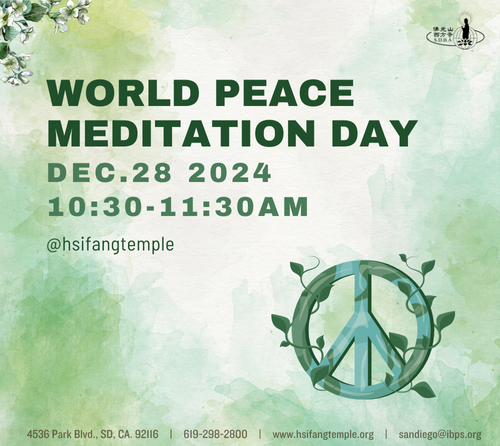Sakyamuni Buddha’s Enlightenment Day – Laba Porridge
Sakyamuni Buddha attained enlightenment on the diamond lotus throne under the Bodhi tree on the auspicious day of 8th in lunar December. This day has come to be known as Buddha Treasure Festival.
During this day, Buddhist monasteries around the world will prepare Laba porridge for the public to enjoy while organising many activities to celebrate the momentous day. The idea of Laba porridge originated from the incidents which occurred during Buddha’s six years of asceticism. At one stage, the Buddha became thin to the bones, and near death. At that time, a shepherd girl offered Buddha a bowl of milk; it was sustenance that saved his life. After regaining strength, Buddha sat meditating under the Bodhi Tree, gazed at the stars and attained enlightenment.
It was the bowl of milk which has given us the conditions to have Sakyamuni Buddha as our teacher, and to commemorate this momentous event, special eight-grain porridge is prepared as an offering to the Buddhas and Bodhisattvas and a chance to form affinities with the ten directions.
Light Offerings Service
The Light offering is one of the ways to practice sharing and giving of brightness to others. It has been practiced since the Buddha’s time. Light symbolizes the brightness of our future; It represents wisdom, lighting up and removing our ignorance, which enables us to see the Truth of life. It is also one of the Ten Offerings in Buddhism, offering of incense, flowers, lights, ointments, fruit, tea, food, Dharma treasures, beads, and clothing.
On New Year, January 1st, we will have a Light Offering Inauguration Service, every first Sundays, we recite the Teachings on Great Compassion, Universal Gate Chapter of Avalokitesvara Bodhisattva and dedicate merit to those who offered lights. By the end of the year, we will have the Light Offering Completion Service to complete the blessings for the year.
In the Merit of Bestowing Lights Sutra, if one sincerely makes offerings of lights to the Buddha within pagodas or temples, one may be blessed in various ways including:
— full and complete limbs and eyes.
— a healthy body and beautiful voice.
— a clear mind, unmoved by ignorance.
— good vision.
— good eyes and cornea.
— a peaceful life without fear
— ease of body and mind with wealth and treasures.
— able to receive jeweled necklaces and groves & gardens.
— a healthful body full of vitality.
— freedom from altercations and fights with others.
— freedom from the afflictions of ignorance.
Great Compassion Repentance Service
The Great Compassion Repentance Service is the practice of the great compassion of Avalokitesvara Bodhisattva and Bodhisattva’s Great Compassion Mantra. The full name of the Great Compassion Mantra literally means, “Thousand-arms and thousand-eyes Avalokitesvara Bodhisattva’s all embracing great compassion Dharani.” The mantra consists of eighty-four phrases. It is very popular in the Chinese culture, and widely recited among devotees. When it comes with the practice of repentance, it is a reflection upon our doing, making sure it is wholesome, and strive not to repeat the same mistake again.
At Hsi Fang Temple, we will have this service three times in a year, during the Bodhisattva’s birthday, renunciation day, and enlightenment day.
It will usually be 3-hour service.
Among the great merits often associated with the Great Compassion Mantra are: rebirth into higher realms, meeting beneficial acquaintances, having competent facilities, bountiful food and wealth, gaining great respect, and the opportunity to learn Buddhist teachings. Also, the water blessed with the Great Compassion Mantra is called the Great Compassion Water, and is taken by devotees for its spiritually cleansing qualities and provides confidence within themselves. Buddhists, who follow the practice of Avalokitesvara Bodhisattva, improves conditions of this life and be more compassionate towards others.
Diamond Sutra Repentance Service
The Diamond Sutra, in Sanskrit Vajracchedika Prajnaparamita Sutra, describe the emptiness nature of all existence and emphasis on the practice of non-attachment and non-self. It relates a series of questions and answers that take place between the Buddha and his disciple Subhuti, regarded as the Buddha’s foremost disciple in understanding emptiness. Their dialog expounds on the empty nature of prajna, an asserts that “all phenomena lack an inherent self” and “all phenomena are transient.”
At Hsi Fang Temple, we will have this service once a month. In this Repentance Service, we recite the Diamond Sutra and prostrate to the Buddhas in intervals between the text. It will usually be a 3-hour service with 15min break in between.
In this sutra, the Buddha guides us in removing our preconception with negation almost throughout the whole sutra. Also, the Buddha shows us how to relate this Teachings and putting this into daily practice. One notable verse from the Diamond Sutra which concludes this Teaching:
“All conditioned phenomena
Are like dreams, illusions, bubbles, and shadows,
Like dew and like lightning;
One should contemplate them in this way.”
Buddha’s Enlightenment Day Service
About 2600 years ago, the Buddha realized the Truth of Dependent Origination, discovering the nature of how existence comes to be and ceases to be whenever there is changes in the causes and conditions. Before realizing the Truth, he practiced six years of ascetic practices where he took only a grain a day. He almost lost his life because of malnutrition. When he overheard the conversation between a father and a son about the question in how to have the best tuned sound from the string instrument, he realized the best way to practice is the Middle Path. Thus, he received a bowl of rice milk from Sujata, regain his energy to continue his practice until he realized enlightenment on December 8th (lunar calendar).
To commemorate this day, we will hold the Buddha’s Enlightenment Day Service and serve everyone with Laba Porridge. (Laba in Chinese means the eighth day of December in the lunar calendar.)







